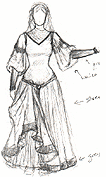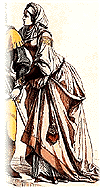German Maiden from the 14th Century
German gowns from the 1300's, with their fitted bodices and low slung girdles, look especially nice on ladies with fuller or hourglass figures. The Germanic influence in this design gives this gown an unusual, yet authentic flavor.
Inspiration
Inspired by drawings from Historic Costume in Pictures by Braun & Schneider, plate No. 21a.
Design Sketch

This gown had several specific design requirements because it was for the Maid of Honor in the wedding. First, it had to complement the color scheme of the bride's gown. For the main gown fabric a flattering dove gray velvet was found which matched the tone of the pale silver of the bride's undergown. For the sleeves and underskirt a stiff white satin with a subtle floral pattern was chosen. Second, it had to be easy to put on, the Maid of Honor needed to be able to dress herself quickly and easily so that she would be free to dress and wrangle the bride. The gown was designed to appear to have separate over and under gowns (in the style of the period), but actually to consist of only one gown with a zipper closure in the rear and sleeve cuffs that buttoned instead of tied. Third, because the Maid of Honor would be standing next to the Bride during the entire ceremony, her dress had to be particularly attractive. A design was developed which used the curvacious figure of the Maid of Honor to advantage, and included delicate and feminine details.
|
Pattern Highlights
The fitted bodice (velvet) for this gown was made from a taping. The gored over (velvet) and under (satin) skirts were assembled separately and attached to the bodice at the low waistline. The moderately poofed half-sleeves (satin) were adorned with long gauntlet cuffs (velvet) and trim was used to hide the seamline between bodice and sleeve. The substantial girdle was created by braiding three strands of large white satin cording (the kind usually used for draperies).
|

Inspiration
1400's German Chatelaine

Finished Garment
German Maiden

|



